You might ask yourself why a fishing rig is needed to catch perch. The truth is, it’s not. Small perch (less then 1 lb) are abundant in most freshwater lakes and pretty easy to catch with a fishing line, #5-8 Aberdeen or J hook, and a worm. However, larger perch in the 1 to 2 pound range are a bit more challenging to hook. Catching larger perch requires skill and the right presentation of bait or lure. This is where a perch rig gets really useful.
If you’re goal is to catch your limit of perch, or reel in a giant trophy perch, then using a perch rig will improve your chances of reaching your limit and landing a of those jumbo perch out there.
Below we’ll introduce you to some of the most effective fishing rigs for catching perch, and discuss which rigs are best suited for various fishing habitat and conditions.
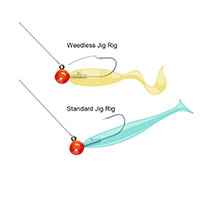
Creates a jerky, vertical motion to attract feeding fresh and saltwater fish
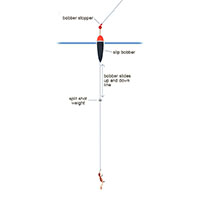
Can be fished at various depth with an easy adjustment to a bobber stop
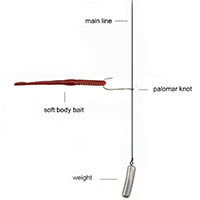
A bass fishing rig that can be fished deep, shallow, and anywhere in between
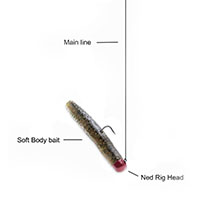
Ideal for fishing tough conditions. Small profile and mimics natural food source
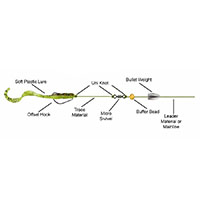
Used for casting and dragging across a target area where fish may be located
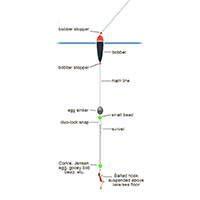
One of the most traditional and effective rigs for catching a large variety of fish
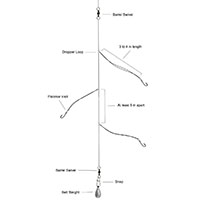
A versatile multi-hooked bottom fishing rig use for bottom fishing and surf fishing

Bottom fishing rig for walleye, bass, trout and catfish feeding near the bottom
Jig Rigs for Perch
A good ‘ol jig rig is about as easy and effective as it gets for hooking perch. You can fish a jig in just about any water conditions, and with the right lure and action you’ll be reeling in perch about as fast as you can get your line in the water—at least in some lakes.
Your basic jig rig for perch fishing includes a 2 to 8 lb test fluorocarbon line, depending on lure size and fishing style. For the smallest lures, a 2 lb test is sufficient. For still-fishing or casting, a 4 to 6 lb test is recommended, and for slow trolling most anglers will take their line size up to about an 8 lb test.
For the basic setup add a standard or weedless 1-3 gram jighead with a soft plastic worm, grub or minnow to the end of the line. A good soft plastic should create irresistible action. This rig can be baited with live worms, grubs, or minnows, but artificials will catch plenty of perch and are much more durable than bait.
A variation of the jig rig—the light spinning perch jig setup—which is used on a fixed spool reel is designed to cast lighter lures a longer distance, yet manage heavier lures as well. This is a versatile jig rig setup good for targeting both small and larger perch at a distance.
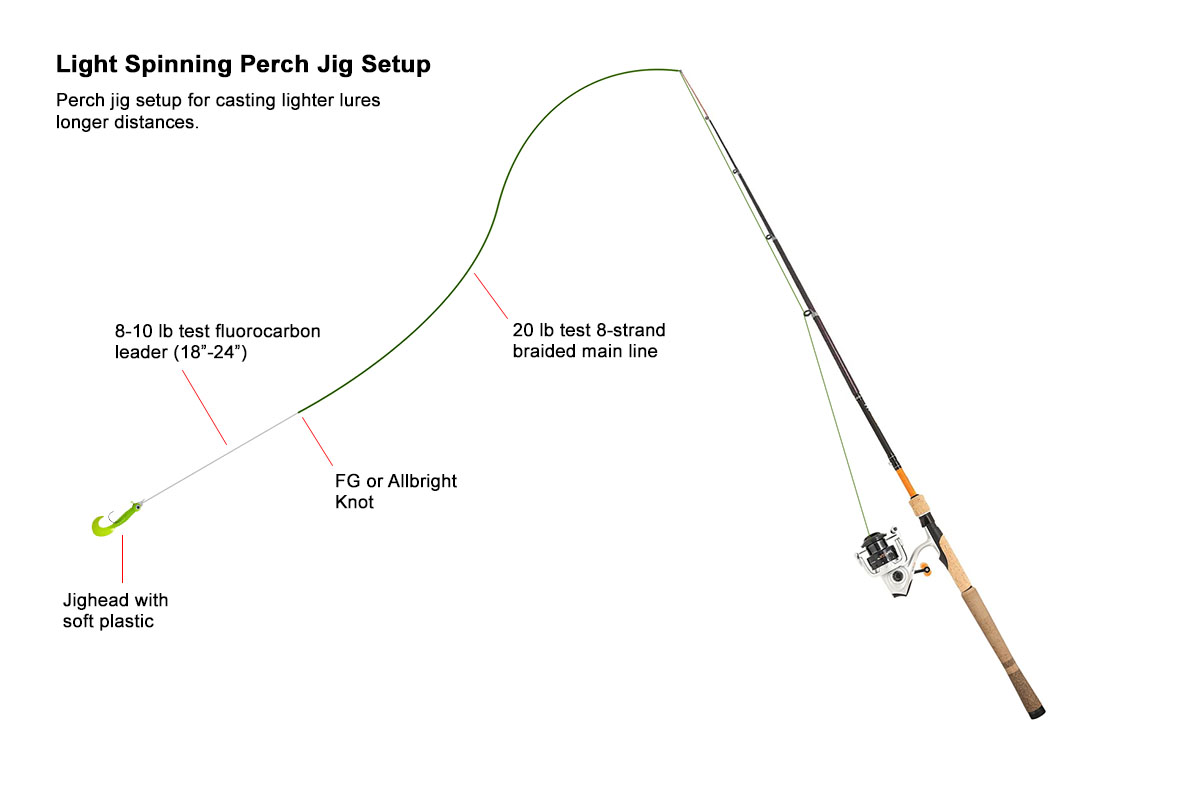
The light spinning perch jig rig setup uses a heavier 20 lb test 8-strand braid for the main line with a 10 lb test attached to a 18-24″ fluorocarbon leader. To ensure the leader passes through th line guides while casting, attach main line to leader using an Allbright of FG knot. Lure options for this configuration are the same as those for the basic setup, but you can also use slightly heavier lures.
The jig rig can be fished using spinning gear or with a baitcaster, but spinning gear is usually the best option if your just getting started. Baitcaster work great for casting light lures if you know how to use one.
A good perch jig rod for either the basic or light spinning setup is 5’6″ to 7′ light (or ultralight) spinning rod. A drop-shotting style rod is ideal for perch fishing. It’s got plenty of backbone for handling larger perch combined with an ultra sensitive tip that imparts life like action to the lure and allows the angler to sense even the smallest bites.
The jig rig reel for perch fishing we recommended is a front-drag fixed-spook reel in the 2500 size range for your 6-7′ rods, and maybe something smaller like a 1000 if you’re fishing small rigs on a shorter 5′-6′ rod.
Slip Bobber Rig
Just about on par with jig rigs for ease and effectiveness of catching perch is the slip bobber rig. Slip-bobbers are all around great panfish rigs, and they work equally as well for catching white and yellow perch.
We’ve found the slip bobber rig works particularly well during later summer, or any other time, when panfish—perch included—tend to congregate and hold in deeper water. Once you know where perch are holding, the adjustable bobber stop on the rig allows you to set your presentation to the specific depth where fish are holding, which is bit more challenging when using a set slip float cast.
What really sets the slip bobber apart from a fixed depth set float, or comparable rig, is casting. Whether your rig is set for a depth of 5 feet or 15 feet, casting with a slip bobber is a cinch. When you’re ready to cast, the bobber slides down to the lure or weight. With a set float rig, it can be difficult to cast if the bobber is more than 3 feet from the bait. It’s casting ability makes the slip bobber an excellent rig to target perch from the bank.
Drop Shot
Dropshotting is a finesse method for fishing perch using a soft plastic bait. The drop shot rig is traditionally used for targeting bass, but also offers several advantages for fishing perch. It provides great control, but more importantly it allows you suspend your lure at any depth in the water column. It’s also a great presentation to use when perch are getting wise to chasing jigs.
A drop shot rig for fishing perch is almost identical to a drop shot for fishing bass. To account for the smaller mouth of the perch, just make sure to downsize your hook. A #4-8 dropshot hook with a weight in the range of 1/8 to 1/4 oz is a perfect configuration for most perch.
One of the keys to the drop shot presentation is ensuring the hook remains at a 90% angel (perpendicular) to the line and point up in the water. To accomplish this, start by threading your line through the underside of the hook. Position the hook where you want it on the line then fasten it in place using the dropper loop knot or a palomar knot.
Fishing a drop shot to catch perch involves a simple technique. Once the weight is on the bottom, jiggle your rod tip to impart some action to the lure. The twitches and lifts of the lure will attract passerbyer perch and entice them to strike.
Ned Rig
Even though it’s not quite as popular as the drop shot, the Ned rig is lethal for landing perch—especially jumbos—when fished correctly. It’s a simple rig, actually as simple as it gets, composed of a Ned rig jighead and soft plastic bait attached to the end of a line.
There are several techniques for fishing the Ned rig but most anglers report that working the rig slow across the bottom produces the most hookups when fishing for perch. When there’s a little current, you can even let the Net rig just move with the water without imparting any additional action from the retrieve.
My favorite technique for fishing the Ned rig, for perch, crappie, and other bottom dwelling panfish is the Drag & Shake where the lure is dragged along the bottom for a few seconds and then a twitching motion is imparted to the lure by gentling shaking the tip of the rod. Great approach to target perch and especially productive during challenging conditions.
One tip I recommend when setting up a Ned rig for perch fishing is to attach your lure to the main line, or leader, using a snap swivel so you can change it out quickly. This will allow you to fish multiple lure types and colors in rapid succession until you zero in on what the perch are biting.
Carolina Rig
The Carolina rig is a great setup for targeting perch in a lake or in the surf. The beauty of the Carolina rig for perch fishing is that there is no lead weight fixed to the bait end of your line. This creates a natural presentation upon retrieve that perch can’t resist.
The Carolina rig should be fished with the sinker weight dragged along the bottom on a slow retrieve. Creature baits and curlytail baits are two top choices for a Carolina rig when targeting lake perch. However, switching up your baits occassionally can keep wary perch off guard and get them biting again.
Surf perch are a different animal altogether than their freshwater cousins, but they also respond well to the magic of the Carolina. Some anglers will argue that the Carolina rig is hands down the best rig for targeting perch in the surf. Don’t know that I’d go that far, but the Carolina is indeed an excellent presentation for all things surf, including croaker, corbin, bluefish and of course surf perch.
In my opinion, what makes the Carolina such a good rig for fishing surf perch is the sliding egg weight that allows the line to move freely in the surf. Fix weight surf rigs just don’t provide the natural presentation and level of sensitivity of the Carolina rig. Gather up some sand crabs, bait your hook, cast into the surf, and wait for a bite.
Float Rig
The set float rig is your quintessential rig for targeting lake and river dwelling panfish—such as perch. It’s simple, it’s reliable, and it’s proven effective. If you know the depth perch are holding, a set float rig will present your bait in a natural fashion at a precise depth.
As simple and reliable as the set float rig is for fishing perch, it’s biggest drawback is the inability to quickly adjust bait depth. If you’re going to use a set float rig you want to have a pretty good idea of the holding depth of perch or locate a school of perch with sonar before dropping your line from above.
Perch will readily take a worm, grub or prawn on a float rig. If you want to eliminate smaller perch from taking your bait stick to larger bait such as prawn and nightcrawlers.
Paternoster Rig
Hands down one of the most effective rigs I’ve used for catching perch. It fishes well in still or running water—fresh or saltwater environments. It’s a versatile presentation that can be fished vertically off the side of a boat, or from the shore at distance or in close. Best of all, it provides little resistance as a perch initially takes the bait.
When targeting perch using live bait I like the float paternoster which I’ll fish with an open bale arm and role over indicator to let me know when I’ve got a bite. A version of the paternoster, the sunk float paternoster, where a float is positioned on the line 1 to 3 feet above the weight (but still beneath the surface) is a configuration I like when fishing over ledges or near structure to avoid snags.
Lindy Rig
Lindy rigs are usually used for walleye, sometimes bass, but they’ll also catch perch. A lindy rig baited with a leech, bloodworm, or nightcrawler is a great way to target perch—especially in many of the midwestern lakes where perch tend to school out on mudflats in deeper waters (25-30′) during the warm summer months.



